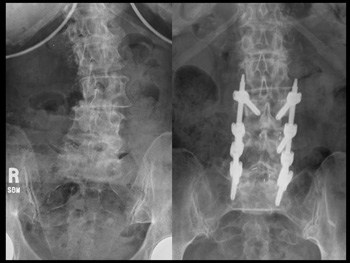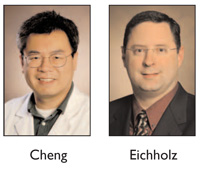
Scoliosis curves the spine of a patient, left. Using a new technique, right, implants are placed through several small incisions to realign the spine.
New technique offers gentler scoliosis surgery option

With scoliosis curving her back at a 43-degree angle, Teresa Dow knew surgery was her best hope.
But the Smyrna, Tenn., woman dreaded the thought of a 14-inch incision opened over her spine as her bones were broken and realigned.
So when Joseph Cheng, M.D., director of the Neurosurgery Spine Program at Vanderbilt Medical Center, offered the choice of a new, less-invasive option, she didn't hesitate.
Dow instead underwent minimally invasive scoliosis surgery, an advanced procedure in which the spine is realigned through several much smaller incisions, using retractor tubes and specialized instruments and implants.
The result: Patients are up walking more quickly, require less pain medication, lose less blood and leave the hospital sooner.
“The recovery is typically three to five days, versus seven to 10 days for an open surgery,” said Kurt Eichholz, M.D., assistant professor of Neurosurgery. “It's cut in half.”
Cheng and Eichholz are two of just a handful of surgeons in the nation who are performing such surgeries in this way.
“This really isn't a revolutionary idea,” Cheng said. “It's an evolution. That's the trend in medicine, asking 'what can we do to help our patients and get them better faster?'
“Over time, we've started readapting our surgical techniques to ask, 'can we do this better, with less trauma to the patient, and still accomplish the same goals?'”
The surgery itself isn't different, Cheng explained.
“At the end of the day, what we're trying to accomplish is all the same,” he said. “The only difference is that we're trying to do it in a kinder, gentler way. We're getting our patients out of the hospital sooner, they're feeling better, they're recovering better and they seem to recover faster.”
During Dow's surgery, Cheng carefully worked through a three-inch incision. Using an osteotome, a chisel-like tool used to cut bone, and a rubber mallet, he chipped away at her spine. Beside him, titanium hardware sat arrayed on a tray. When the procedure was finished, he had used two metal rods, 17 screws and two cross-link plates to reconstruct Dow's backbone.
The technique does take 20 percent to 30 percent longer than the open-spine method, “because it's easy enough to make a big cut and all of a sudden everything's right there, versus working through small holes,” Cheng said.
But the benefits more than make up for the extra time needed, both physicians agree.
“You pay a little bit more in terms of operating time, but you certainly have several advantages,” Eichholz said. The lower blood loss “is a huge advantage, especially for older patients.”
It's a case-by-case decision whether a patient is a candidate for the surgery, he said.
“There are certain things that we don't want to do this way,” Eichholz said, including operating on patients with traumatic injuries, long-term scoliosis or those needing a revision of a previous surgery. “If somebody already has rods and screws in, you can't really apply this.”
Cheng estimated that about 15 percent of deformity surgeries could be performed this way.
“The patients benefiting the most seem to be those who would not have done well with a longer hospitalization stay,” he said. “That includes patients who need to return to work quickly or want to stay more active, as well as older patients who are at higher risk of complications from a longer hospital stay, such as pneumonia.
Carleen Belcher of Murray, Ky., researched her options before choosing Eichholz and the minimally invasive technique.
“I didn't want an open-back operation because the healing time is so much greater,” she said. “It worked amazingly. I had just these little bitty wounds on my back.”
She was in the hospital for three days, and the pain relief was instantaneous.
“We knew people who had the open-back surgery, and had heard their stories of being off of work for a year,” she said. “I'm very happy. My surgery was a success, and it was an easy recovery.”













